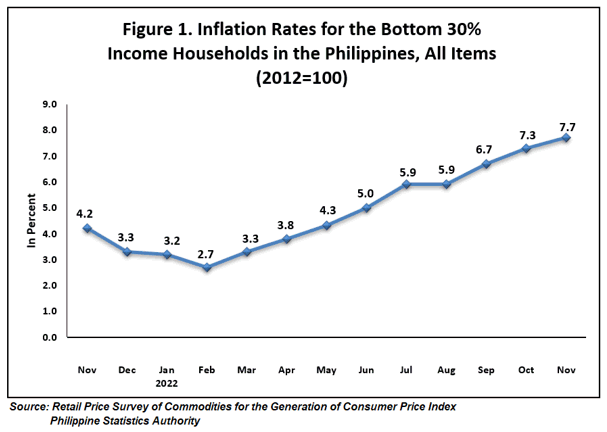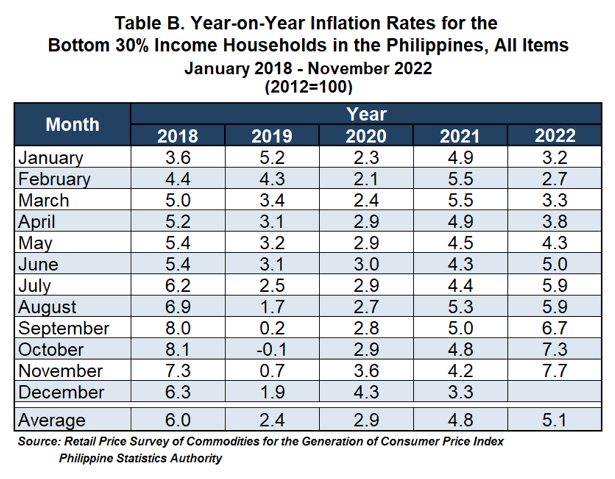Table A. Year-on-Year Inflation Rates for the
Bottom 30% Income Households, All Items
In Percent
(2012=100)
| Philippines | 4.2 | 7.3 | 7.7 | 5.1 |
| NCR | 1.5 | 9.1 | 9.0 | 5.0 |
| AONCR | 4.3 | 7.2 | 7.7 | 5.2 |
| Source: Retail Price Survey of Commodities for the Generation of Consumer Price Index Philippine Statistics Authority *Year-on-year change of average CPI for January to November 2021 vs. 2022 | ||||

1. Philippines
Inflation in the Philippines for the bottom 30 percent income households further increased to 7.7 percent in November 2022, from 7.3 percent in October 2022. This is the highest recorded inflation for this income group of consumers since October 2018. The average inflation rate from January to November 2022 stood at 5.1 percent. In November 2021, inflation rate was recorded at 4.2 percent. (Tables A and B, and Figure 1)
The higher inflation for this group of consumers is brought about by the increase in the year-on-year growth of the food and non-alcoholic beverages and tobacco index at 8.2 percent in November 2022, from 7.5 percent in October 2022 and restaurants and miscellaneous goods and services index at 6.0 percent, from 5.5 percent in October 2022. The rest of the commodity groups also recorded higher year-on-year increments except for the housing, water, electricity, gas and other fuels index which retained its previous month’s growth rate. (Tables 3 and 4)
Food inflation at the national level rose to 8.5 percent in November 2022, from 7.7 percent in October 2022. In the same month of the previous year, food inflation was recorded at 4.2 percent. (Table 7)
The increase in the food inflation was primarily driven by the higher annual mark-up in the vegetables index at 14.8 percent, from 9.3 percent in October 2022. In addition, annual growth of the sugar, jam, honey, chocolate and confectionery index was also higher at 59.5 percent, from 54.9 percent in October 2022.
Faster annual increments were also observed in the indices of the following food groups during the month:
a. Rice, 1.7 percent;
b. Corn, 10.7 percent;
c. Other cereals, flour, cereal preparation, bread, pasta and other bakery products, 8.3 percent;
d. Fish and seafood, 7.8 percent;
e. Milk, cheese and eggs, 8.5 percent;
f. Oils and fats, 17.8 percent; and
g. Food products not elsewhere classified (n.e.c), 6.9 percent.
On the other hand, the indices of meat and fruit posted lower annual increases of 9.3 percent and 5.9 percent, respectively. (Table 5)

2. National Capital Region (NCR)
Inflation in NCR was recorded at 9.0 percent in November 2022, from 9.1 percent in October 2022. In November 2021, the inflation in the area was posted at 1.5 percent. (Tables A and 3)
The lower inflation in the area was mainly brought about by the lower annual increment for the index of housing, water, electricity, gas, and other fuels at 4.0 percent in November 2022, from 4.4 percent in October 2022. In addition, lower annual increases were also observed in the indices of food and non-alcoholic beverages at 10.4 percent and transport at 18.7 percent.
On the other hand, annual increments were higher in the indices of the following commodity groups:
a. Clothing and footwear, 2.3 percent;
b. Furnishings, household equipment and routine household maintenance, 4.4 percent;
c. Health, 2.0 percent;
d. Recreation and culture, 2.0 percent; and
e. Restaurants and miscellaneous goods and services, 11.1 percent.
The rest of the commodity groups retained their previous month’s year-on-year growth rates. (Tables 3 and 4)
3. Areas Outside NCR (AONCR)
Following the trend at the national level, inflation for this particular income group in AONCR moved up to 7.7 percent in November 2022, from 7.2 percent in October 2022. In November 2021, inflation in AONCR was recorded at 4.3 percent. (Tables A and 3)
The higher year-on-year increment in the food and non-alcoholic beverages index at 8.1 percent in November 2022 mainly contributed to the uptrend of inflation in the area. The higher annual growth rate of the restaurants and miscellaneous goods and services index at 5.7 percent, also contributed to the uptrend in the overall inflation. The rest of the commodity group recorded faster annual growth rates. (Tables 3 and 4)
Relative to their respective previous month’s rates, 13 regions in AONCR registered higher inflation for the bottom 30 percent income households in November 2022. Region VII (Central Visayas) remained the region with the highest inflation rate at 9.5 percent, while region XIII (Caraga Region) had the lowest inflation rate at 5.7 percent. (Table 4)
Note: CPIs and inflation rates for the bottom 30% income households by region are posted at the PSA website (http://openstat.psa.gov.ph/).
DENNIS S. MAPA, Ph.D.
Undersecretary
National Statistician and Civil Registrar General
See more at the Consumer Price Index for Bottom 30% Income Households main page.
